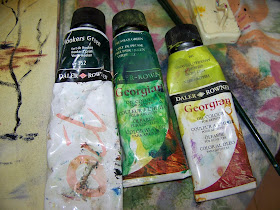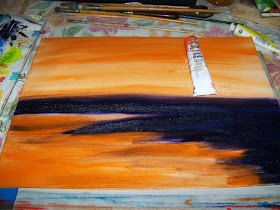I start this project on a sheet of Prime Art Canvas Pad.
I tear one sheet of canvas from the pad to paint on.
I then mix turpentine and Raw Sienna on my palette.
I use a clean cloth to cover the background in the turpentine and paint mixture.
This is what my canvas looked like with the background painted.
I then mixed a light blue from Phthalo Blue and Titanium White.
I painted the sky and the stream in this colour mix.
Next, I used Burnt Umber for the shadow sides of my trees and Red Ochre for the sides exposed to the light.
Hold your brush at the end to relinquish control of the brush when painting the tree trunks and branches.
Remember to consider the direction your light comes from when painting light and shadow areas.
Dark patches are added to start a definition of the ground.
Further definition is added.
I mixed my own black from Permanent Violet and Phthalo Blue.
This was used to paint the more distant trees.
Foliage would be added using Hooker's Green, Prussian Green and Yellow Green.
Foliage is added.
More foliage is added.
Time to add the happier colours and sun patches. I used Cadmium Orange, Deep Cadmium Yellow and Pale Cadmium Yellow.
Foliage and light patches are added.
The foreground is developed.
More defined foliage is added to the foreground.
I now brought Naples Yellow to the painting.
Sunny areas were added along with highlights.
I decided to add yet another green by bringing Chrome Oxide to the painting.
I painted bushes and grass into the painting by flicking a fan brush across the surface.
The completed painting left me with a feeling that I should go home and work some more on the painting. However, I probably never will, so I might as well add this blog now. This painting has too much clutter to satisfy me. I am an organized person by nature and this painting has ceased to be my voice. Throwing more paint at it, will not satisfy me. This is why it is true that art always tells you something about the artist behind it, even if it only tells you more about their dislikes than their actual likes. Have you found your own artistic voice yet?
Marietjie Uys (Miekie) is a published author. You can buy the books here:
You can purchase Designs By Miekie 1 here.
Jy kan Kom Ons Teken en Verf Tuinstories hier koop.You can purchase Designs By Miekie 1 here.
Jy kan Kom Ons Kleur Tuinstories In hier koop.
Jy kan Tuinstories hier koop.
You can follow Miekie's daily Bible Study blog, Bybel Legkaart, here in English & Afrikaans.
For more crafty ideas and great products, visit A Pretty Talent on Facebook.
Remember to keep nurturing your TALENT for making PRETTY things.
You can subscribe to this blog and receive regular updates by email by simply registering your email address at the top of the current blog.





























































